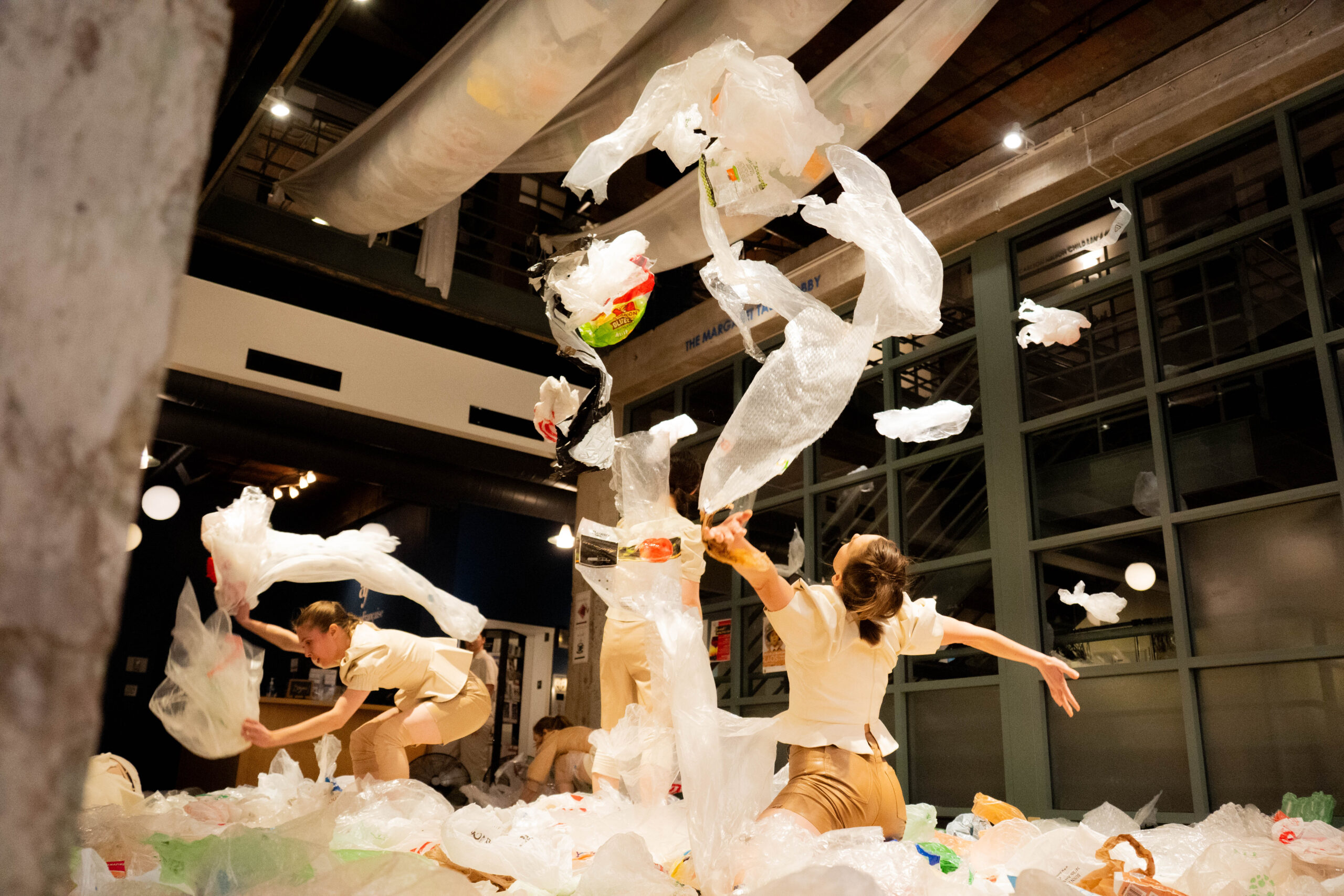By: Aby Gervais
In preparation for a performance she likes to describe as “Nightmare Escape on Plastic Island,” Brenna Mosser tightens the hammocks filled with single-use plastic, which hang over the stage, waiting to be dropped mid-performance.
Mosser looks nervous as she sets up fans on the left side of the stage, putting her hand on her chin as she checks to see how they are positioned. Her dancers, however, are in a circle warming up with inviting smiles on their faces.
For three months, Mosser collected single-use plastic from friends, family, neighbors and plastic drives. During the performance, Target bags, bubble wrap and even a Dum-Dums sucker bag engulf the dancers as they are shaken out of the hammocks.
The stage’s wood floor is barely recognizable because of the array of colors. The red of the Target logo stands out in the crowd of plastic, allowing the scene to be familiar to those watching. There are moments during the performance where the dancers are almost completely concealed.
Mosser, 33, is a dance artist based in Minneapolis and the mastermind behind the piece. Born and raised in Rochester, Mosser found her way to the Twin Cities dance scene in 2018. Beyond dance, she dedicates her time to the French Cultural Center, Alliance Française, as a bookkeeper.
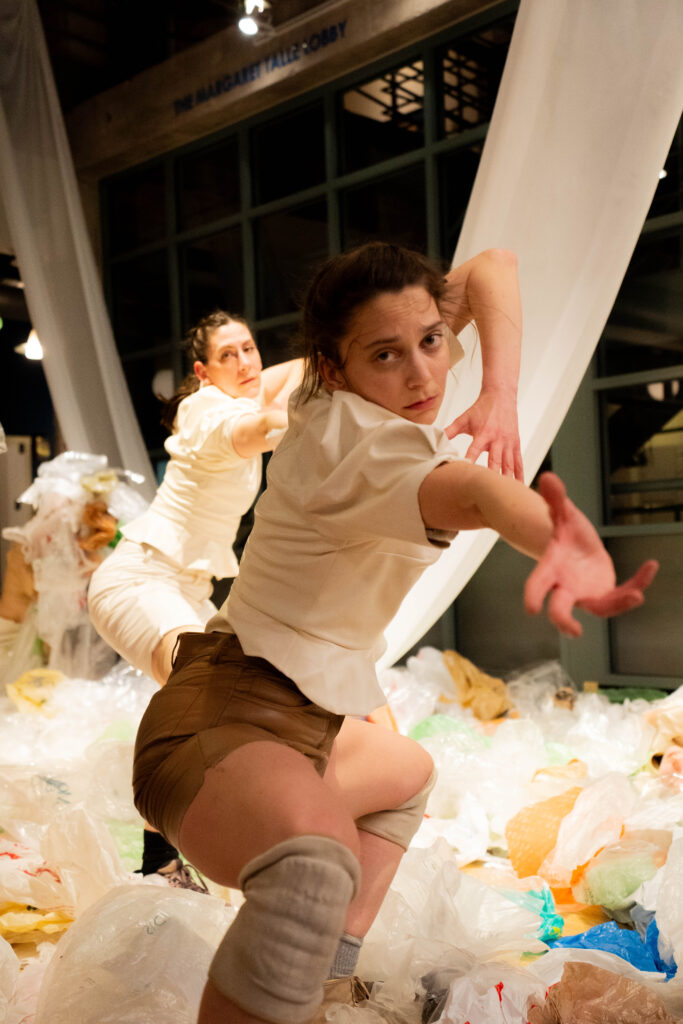
In more recent choreographic work, Mosser explained her way of thinking about choreography and how to go about it.
“Dance is something you can say without words,” she said.
While creating the initial movement for her new ideas, she starts with what she describes as the “fuzzy cotton ball idea” of what she wants to do. But it takes quite a while to chip away and ultimately fine-tune it into something digestible for an audience.
While her passion for dance shines through, Mosser’s love of the environment fights for the spotlight as well. She was inspired by her time in dance as a child and participating in environmental programs as an adult to blend her two passions together.
Mosser spent her early 20s in Europe studying dance and developing an understanding of the art of movement. She received her bachelor’s degree in dance performance from the Trinity Laban Conservatoire of Music and Dance in London, and then moved to Angers, France, to work with world-renowned dance companies.
At around 24 years old, once she was back on U.S. soil, Mosser decided to join the Conservation Corps Minnesota & Iowa, a program for a variety of ages to give back to the community through environmental work according to the Conservation Corps’ website.
After Mosser entered the Twin Cities dance scene, Analog Dance Works came to life. The dance company’s mission is to provide a space where artists can explore the intersection between dance and science.
Mosser dedicates her passion to her family, who supported Mosser in her understanding of art and science more deeply by engaging in “spectacular” entire-family conversations about these topics.
Her most recent choreographic work, “The Awe Factor,” which includes “Nightmare Escape on Plastic Island,” attempts to inspire people with the same love of the environment that she has. She hopes it will inspire conversation and ultimately, change.
“The Awe Factor” premiered in the Spring of 2024 at the TEK BOX at the Hennepin Center for the Arts in Minneapolis. Now, almost a year later, she brought the choreography back to life.
For the reprise, Mosser used the plastic element within her piece to highlight the Zero Waste Challenge by Hennepin County. During February, the challenge spread awareness of how limiting single-use plastics can make an impact on climate change, according to the Plastic-Free Challenge’s website.
This time around, Mosser donated the plastic after the performance, in hopes to give it one more life. One of the ways it will be recycled is into new city park benches for Hennepin County.
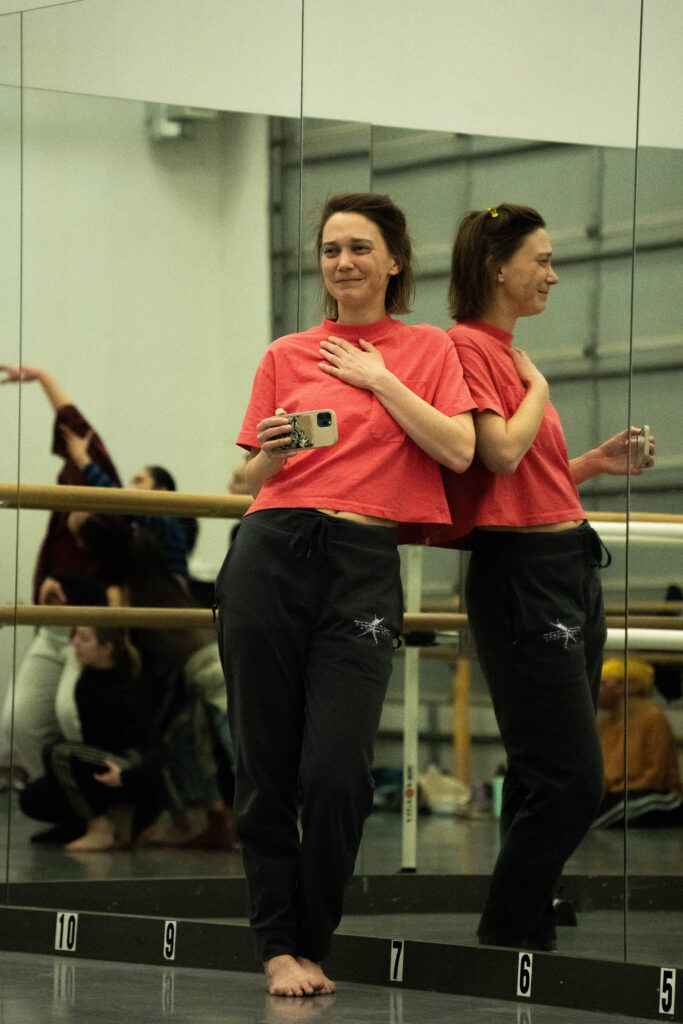
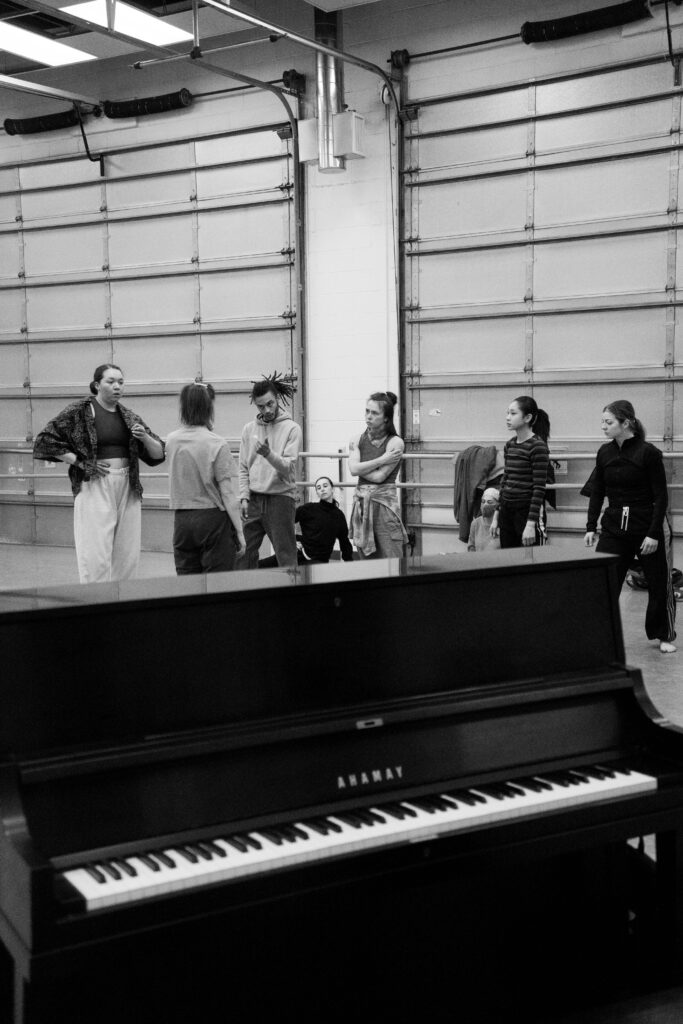
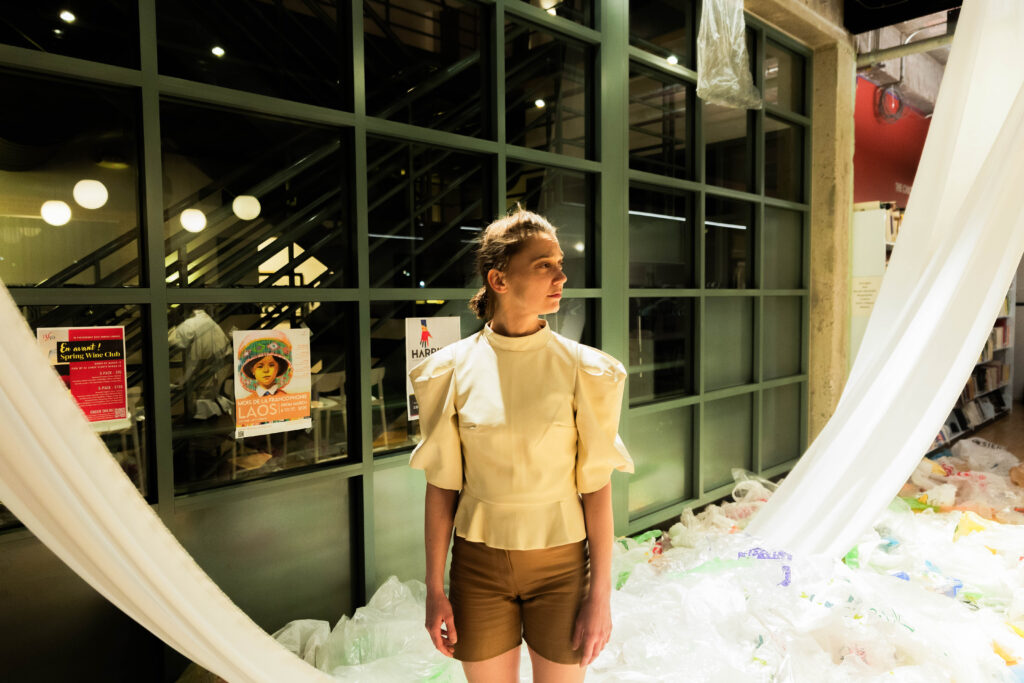
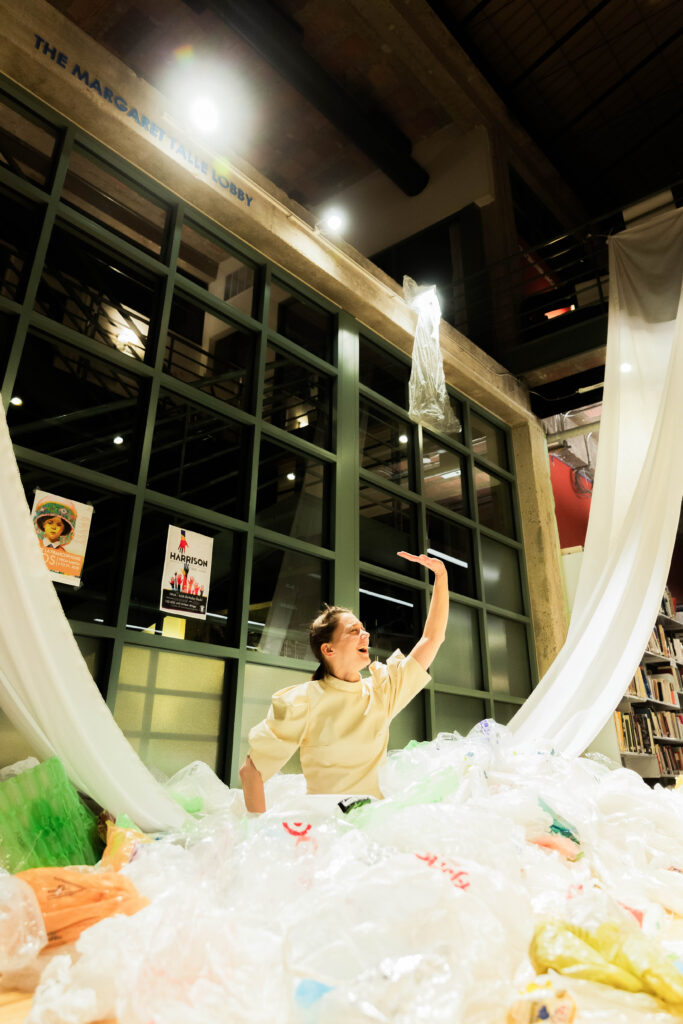

The Choreography Process
Choreography can be a lengthy process, sometimes taking months to craft a performance-ready piece. Mosser dedicates a lot of her initial time to researching the topics she wants to illustrate through movement.
When an idea strikes her, Mosser turns to a few routes to begin expressing it in physical movement. Sometimes a specific movement pops into her head. However, reading and conversations with experts in the field can also spark her creativity.
Mosser wants to make people fall in love with the environment through dance. This core idea drives her conversations with experts.
For her upcoming project, Mosser was invited to the Artist-in-residence program at the University of Minnesota’s College of Biological Sciences. She met with multiple scientists to further develop her idea and ask them about their own connections to the environment.
Mosser won’t stop at just getting people to care. She hopes to create a sense of awe, which she describes as “that kind of resonating feeling in your chest,” whether it is dance as an art form or the environment as a whole.
Mosser interprets choreography as an unveiling journey, creating that sense of awe when the audience realizes the story behind a dance.
Once an idea is set in stone, she turns to improvisation. This type of movement allows Mosser and her dancers to use all five senses to paint a story and garner images.
This choreography journey can be a long process for not only Mosser, who is constantly teasing out what is working, but the dancers as well. Mosser spends a lot of time taking notes or videos of what she likes, or where a set of movements is at for the time being. The dancers are expected to practice the movement and see where it takes them.
While Mosser has ideas of what she wants in a piece, she is not married to an idea.
“If something is not working, let’s find something else that will work,” she said.
There is a middle ground where intended choreography meets individual choice for dancers. Mosser, who performed in her own reprise due to a dancer’s illness, said it was scary to do her own movements.
“A lot of the movement feels good in my body, which is because I choreographed it,” she said. “But a lot of the movement as well, I was like, I know this is a challenge, and I’m maybe not the best dancer for it, but this is what I want to have happen.”

Mosser said that each dancer will ultimately have their own journey in any performance, and she is curious about all of them. However, each dancer’s journey should be based on the choreography.
Next Steps for Mosser
It was the second day of rehearsal for Mosser’s upcoming project, Converge. Mosser took out her nude knee pads, notebook and pencil, a water bottle and a book titled “The Light Eaters: How the Unseen World of Plant Intelligence Offers a New Understanding of Life on Earth,” by Zoë Schlanger.
There were seven dancers present at the rehearsal, which began with a warmup.
“This week is teasing out transitions,” Mosser said to her dancers as they stretched in a circle. There was a serious, yet inviting energy in the room as Mosser went through movements by herself, and the dancers kept to their conversations, often filled with laughter.
While Mosser creates the movement, the dancers each have a stake in how they ultimately perform. Jayde Grass, a dancer in Mosser’s Converge, describes dance as a way for the body to speak for oneself.
“Dance is the most universal language,” she said.
Mosser works with the dancers to create something they ultimately all feel comfortable doing – and communicate it to an audience.
“Good choreography takes you through a journey, and you have no idea where you’re going,” she said. “And then all a sudden, everything you’ve seen makes sense.”
